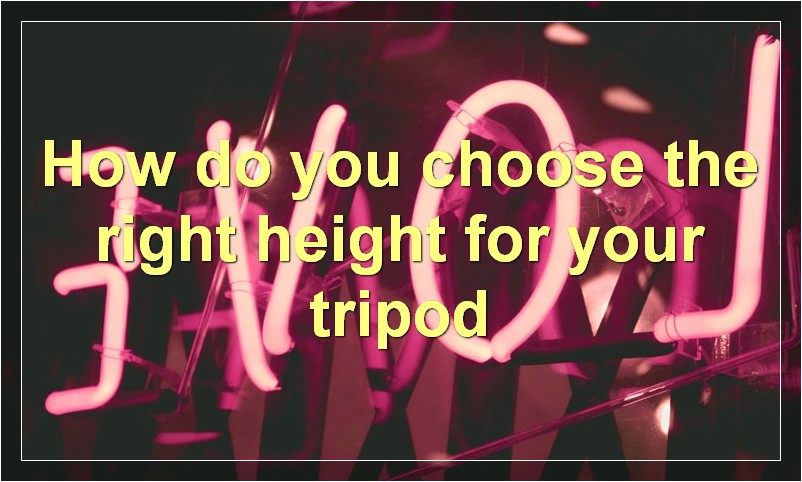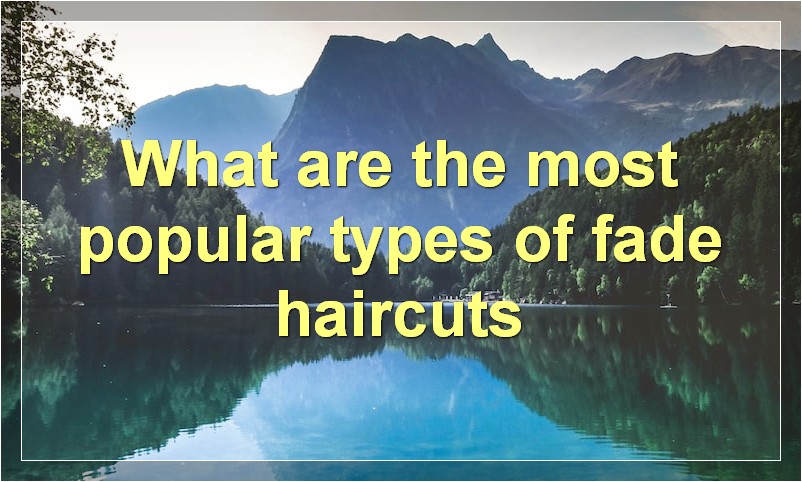If you’re serious about birdwatching, then you know that a good spotting scope is key. But what many people don’t realize is that an equally important piece of equipment is a tripod. In this article, we’ll give you a few tips on how to choose the right tripod for your spotting scope.
What factors should you consider when choosing a tripod for your spotting scope?
When choosing a tripod for your spotting scope, there are many factors you need to consider in order to get the perfect one for your needs. The first and most important factor is the height of the tripod. You need to make sure that the tripod is tall enough so that you can comfortably look through your spotting scope without having to stoop over. The next factor you need to consider is the weight of the tripod. If you plan on using your spotting scope in windy conditions, you will need a heavier tripod to keep it stable. The third factor to consider is the material of the tripod. Aluminum tripods are lightweight and easy to transport, but they are not as sturdy as carbon fiber tripods. Carbon fiber tripods are more expensive, but they are worth the investment if you plan on using your spotting scope in rough conditions. The fourth factor to consider is the type of head on the tripod. Pan heads allow you to pan the scope left and right, while ball heads allow you to tilt the scope up and down. Choose the type of head based on how you plan on using your spotting scope. If you plan on doing a lot of long-distance viewing, a pan head would be more beneficial. If you plan on taking pictures with your spotting scope, a ball head would be better suited for that purpose. The fifth and final factor to consider is the price. Tripods range in price from around $100 to over $1000. Choose a tripod that fits your budget and meets your needs.
What are the benefits of using a tripod for your spotting scope?

A tripod is an essential tool for any nature lover who wants to get the most out of their spotting scope. Here are four reasons why a tripod is an important piece of equipment for anyone who enjoys spending time outdoors:
1. A tripod provides stability.
One of the main benefits of using a tripod is that it provides stability. This is especially important when using a high-powered spotting scope, as any shake or vibration can make it difficult to get a clear view. A tripod ensures that your scope will be steady, so you can get the most out of your viewing experience.
2. A tripod allows you to use lower light settings.
Another benefit of using a tripod is that it allows you to use lower light settings on your spotting scope. This means that you can extend your viewing time into the evening and early morning hours, when wildlife is often most active.
3. A tripod gives you the freedom to explore your surroundings.
A tripod also gives you the freedom to explore your surroundings. With your hands free, you can take pictures, make notes, or even just enjoy the scenery. This can be especially helpful if you’re birdwatching, as you’ll be able to quickly identify and track birds in your area.
4. A tripod is a great investment.
A tripod is a great investment for anyone who loves spending time outdoors. Not only will it improve your viewing experience, but it will also last for many years with proper care.
How does a tripod help stabilize your spotting scope?
A tripod is an extremely important tool for anyone using a spotting scope. It helps to stabilize the scope, which is important for getting a clear image. A tripod also allows you to position the scope in the perfect spot for viewing. If you are birding, for example, you can position the scope so that you have a clear view of the bird feeder. A tripod is also helpful if you are trying to view something in the distance, as it will help to steady the scope and prevent any unwanted movement.
What types of tripods are available for your spotting scope?
When you are out in the field tracking game, the type of tripod you use can make all the difference in getting that perfect shot. There are many different types and brands of tripods available on the market, so how do you know which one is right for you and your spotting scope? In this article, we will take a look at the different types of tripods available and help you choose the best one for your needs.
Tripods come in all shapes and sizes, but there are three main types that are most commonly used with spotting scopes. These are:
1. Monopods
2. Tripod Sticks
3. Standard Tripods
Monopods are single-legged support structures that are typically used in conjunction with another support, such as a tree or fence post. They are ideal for quick set-ups and take-downs, and can be easily carried in a backpack or vehicle. Monopods are not as stable as other types of supports, but they can be helpful in a pinch.
Tripod sticks are similar to monopods, but have three legs instead of one. This provides more stability than a monopod, but they are still not as stable as a standard tripod. Tripod sticks are also easier to carry and set-up than standard tripods.
Standard tripods are the most stable type of support for spotting scopes. They have three legs that can be adjusted to different heights, and a center column that can be raised or lowered. Standard tripods are more difficult to carry and set-up than other types of supports, but they offer the best stability for your scope.
When choosing a tripod for your spotting scope, consider the type of terrain you will be using it on. If you will be using it on uneven ground, a tripod with adjustable legs is a good option. If you plan on using it on smooth, level ground, a standard tripod will work fine.
The height of the tripod is also an important consideration. You want to make sure that the tripod is tall enough so that you can comfortably look through your scope without having to stoop over. However, you don’t want it to be so tall that it is difficult to maneuver. A good rule of thumb is to choose a tripod that is about shoulder height when extended to its full height.
Finally, consider the weight of the tripod when making your selection. Heavier tripods provide more stability, but they can be difficult to carry long distances. Lighter tripods are easier to carry, but may not be as sturdy in windy conditions. Choose the heaviest tripod that you are willing to carry, based on the type of hunting you will be doing.
There are many different brands and models of tripods available on the market today. Some of the more popular brands include Manfrotto, Gitzo, and Slik. When selecting a brand, consider your budget and read online reviews to see what others have to say about the quality of the products.
Now that you know more about the different types of tripods available, you can make an informed decision about which one is right for you and your spotting scope. With a little research, you can find the perfect tripod to help you get those perfect shots out in the field!
What is the best tripod material for your spotting scope?
When you are out in the field, one of the most important things to have is a tripod. A tripod will help stabilize your spotting scope, making it easier to get a clear image. But what is the best material for a tripod?
There are three main materials that tripods are made from: aluminum, carbon fiber, and wood. Each has its own advantages and disadvantages.
Aluminum is the most common material for tripods. It is strong and lightweight, making it easy to carry. However, aluminum is not as stable as other materials. It is also susceptible to corrosion.
Carbon fiber is another popular material for tripods. It is very strong and lightweight, like aluminum. However, it is more expensive than aluminum. Carbon fiber is also not as stable as other materials.
Wood is the least common material for tripods. It is heavy and not as strong as aluminum or carbon fiber. However, wood is very stable. It is also less likely to corrode than aluminum.
So, which material is the best for a tripod? It depends on your needs. If you need a lightweight tripod that is easy to carry, aluminum or carbon fiber may be the best option. If you need a very stable tripod, wood may be the best option.
How do you choose the right height for your tripod?

When it comes to choosing the right tripod height, there are a few things you need to take into account. The first is the type of camera you’re using. If you’re using a DSLR, then you’ll need a taller tripod than if you’re using a point-and-shoot. The second is the lens you’re using. A telephoto lens will require a taller tripod than a wide-angle lens. And finally, you need to consider the angle you want to shoot at. If you want to shoot at a low angle, then you’ll need a shorter tripod; if you want to shoot at a high angle, then you’ll need a taller tripod.
So how do you choose the right tripod height? First, make sure you know the minimum and maximum height your tripod can extend to. Second, decide what kind of camera and lens you’re using. Third, determine the angle you want to shoot at. And fourth, adjust the tripod legs until it’s at the correct height.
How do you choose the right leg length for your tripod?
When you’re out shooting, one of the last things you want to worry about is your tripod. You want something that’s going to be sturdy, reliable, and easy to use. But with all the different brands and models on the market, it can be tough to know where to start.
One of the most important factors in choosing a tripod is leg length. Most tripods have legs that can be extended to different lengths, and the right length will depend on a few different factors. In this article, we’ll break down everything you need to know about tripod leg length so you can make the best decision for your needs.
What is the ideal leg length for a tripod?
There is no “ideal” leg length for a tripod, as it will vary depending on a few different factors. The first is the type of photography you’re doing. If you’re shooting landscapes, you’ll likely want a longer tripod so you can get your camera higher off the ground. This will give you a more expansive view of the scene and also help reduce distortion from shooting at a low angle.
If you’re doing portrait photography or other types of photography where you need to be close to your subject, a shorter tripod will be more appropriate. This will help prevent your camera from being too high above your subject, which can cause unflattering angles.
The second factor to consider is the height of your camera. A taller tripod will be necessary if you’re using a large DSLR or mirrorless camera with a heavy lens. Conversely, if you’re using a smaller point-and-shoot camera, a shorter tripod will be just fine.
The third factor is the terrain you’ll be shooting on. If you’re shooting on uneven ground, longer legs will give you more stability and prevent your camera from tipping over. Shorter legs can be helpful in tight spaces where a longer tripod would just get in the way.
Keep all these factors in mind when choosing the right leg length for your tripod!
How do I extend or retract the legs on my tripod?
Most tripods have legs that can be extended or retracted to different lengths. To extend the legs, simply loosen the locks and pull each leg out to the desired length. To retract the legs, do the same thing in reverse – tighten the locks once the legs are at the desired length. Some tripods also have levers or knobs that can be used to adjust the leg length without having to loosen and tighten any locks.
Depending on the model of tripod, there may also be different ways to set up the legs. Some tripods have legs that can be positioned at different angles, which can be helpful in getting low-to-the-ground shots or fitting into tight spaces. Others have legs that collapse inward, which can make them more compact for storage or transport. Experiment with different configurations to see what works best for you and your photography needs!
What is the best head type for your tripod?
When you’re looking for a tripod, one of the most important factors to consider is the head type. The head is what allows you to pan and tilt the camera, and it also supports the weight of your equipment. There are several different types of heads available, and each has its own advantages and disadvantages.
Ball Heads
Ball heads are the most popular type of tripod head, and for good reason. They’re relatively inexpensive, easy to use, and they offer a wide range of motion. Most ball heads have a single knob that controls both panning and tilting, which makes them very user-friendly.
One of the main disadvantages of ball heads is that they’re not as sturdy as some of the other options. If you’re using a heavy lens or long exposure times, you might want to consider a different type of head. Ball heads are also more prone to vibration than other types of heads.
Pan/Tilt Heads
Pan/tilt heads are very similar to ball heads, but they have separate knobs for panning and tilting. This gives you more control over the camera, but it can also be more time-consuming to adjust. Pan/tilt heads are a good choice for video cameras, since they allow you to make smooth pans and tilts.
Like ball heads, pan/tilt heads are less sturdy than some other options. They’re also more susceptible to vibration, so they’re not ideal for long exposures or heavy lenses.
Gimbal Heads
Gimbal heads are designed for use with long lenses, such as telephoto lenses. They have a horizontal arm that supports the weight of the lens, and they allow you to pan and tilt the camera without moving the lens. This makes them ideal for tracking moving subjects, such as wildlife.
Gimbal heads are more expensive than other types of heads, and they can be tricky to use. They’re also not well-suited for short lenses or small cameras.
Pistol Grips
Pistol grips are unique in that they don’t have a traditional tripod mount. Instead, they have a grip that you hold onto while you shoot. This gives you more stability when hand-holding the camera, but it can be tiring to hold onto for extended periods of time.
Pistol grips are best suited for short lenses and small cameras. They’re not stable enough for long exposures or heavy lenses, and they’re not compatible with all tripods.
Which Head is Right for You?
When choosing a tripod head, there are several factors to consider. First, think about what type of photography you’ll be doing most often. If you plan on using long lenses or shooting video, a gimbal head or pan/tilt head might be a good choice. If you mostly shoot landscapes or portraits, a ball head will probably suffice. Second, consider your budget. Gimbal heads and pistol grips are typically more expensive than other types of heads. Third, think about the weight and size of your equipment. Heavier lenses will require a sturdier head, while lighter cameras can be used with any type of head.
Should you get a tripod with a pan or tilt head?
A tripod is an essential piece of equipment for any photographer, whether you are shooting landscape or portraits, action or product shots. But which type of tripod head is right for you? In this article, we will compare pan and tilt heads, to help you decide which one is best for your needs.
When choosing a tripod head, the first thing to consider is what type of photography you will be using it for. If you are mostly shooting landscape or still-life images, then a pan head is a good choice. Pan heads offer smooth, precise movement and allow you to pan your camera around your subject while keeping the horizon level. They are also relatively lightweight and easy to operate.
If you are mostly shooting video or action shots, then a tilt head is a better choice. Tilt heads offer more range of motion than pan heads, so you can tilt your camera up or down as well as side to side. This gives you more flexibility when framing your shots. Tilt heads are also generally more rugged and durable than pan heads, making them better suited for heavy use.
So, which type of tripod head is right for you? If you are mostly shooting landscape or still-life images, go with a pan head. If you are mostly shooting video or action shots, go with a tilt head. And if you are unsure, get a tripod with both types of heads so you can use either one depending on the situation.
What are some other accessories you might need for your tripod?
When you’re setting up your tripod, you might need a few extra accessories to get the perfect shot. Here are a few things you might need:
A level: You want your tripod to be level so your photos are straight. A small bubble level is an easy way to make sure your tripod is level.
A remote shutter release: This will let you take photos without touching your camera, which can cause shake and blur.
Extra batteries: If you’re using a digital camera, you’ll probably need extra batteries since they tend to drain quickly.
A carrying case: A carrying case will protect your tripod when you’re transporting it.




